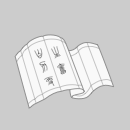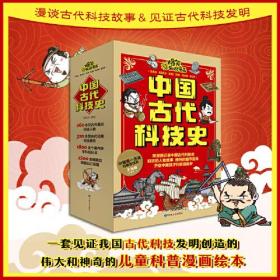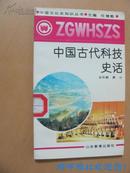
中国古代科技史
正版全新
¥ 55.77 5.2折 ¥ 108 全新
库存4件
上海浦东
认证卖家担保交易快速发货售后保障
作者中国科学院自然科学史研究所 编著
出版社外文出版社
ISBN9787119057545
出版时间2009-08
装帧精装
开本16开
纸张胶版纸
页数632页
定价108元
货号614045
上书时间2024-05-07
- 在售商品 暂无
- 平均发货时间 25小时
- 好评率 暂无
- 最新上架
商品详情
- 品相描述:全新
- 商品描述
-
【书 名】 中国古代科技史
【书 号】 9787119057545
【出 版 社】 外文出版社
【作 者】 中国科学院自然科学史研究所 编著
【出版日期】 2009-08-01
【版 次】 1
【开 本】 16开
【页 码】 632
【定 价】 108.00元
【内容简介】
Catalogued according to different scientific fields, the book draws wisdom from authoritative experts in the institute of the History of Natural Sciences (IHNS) from the Chinese Academy of Sciences (CAS), and comprehensively introduces ancient Chinas scientific and technological achieve- ments in such fields as astronomy, mathematics, physics, chemistry, geology, biology, agriculture, medicine, printing, spinning and weaving, metal-lurgy and foundry, machinery, architecture, ship-building and navigation, and military technology, etc. This book is Of high academic quality yet writ- ten in the simplest language possible, and thus is a very readable popular science collection.
【目录】
PREFACE
RECORDS OF ASTRONOMICAL EVENTS
ASTROMETRY AND ASTROMETRIC INSTRUMENTS
CHINESE CALENDARS
MATHEMATICAL CLASSICS
THE DECIMAL PLACE-VALUE NUMERATION AND THE ROD AND BEAD ARITHMETICS
THE OUT-IN COMPLEMENTARY PRINCIPLE
METHOD FOR DETERMINING SEGMENT AREAS AND EVALUA- TION OF
THE CHINESE REMAINDER THEOREM
THE NUMERICAL SOLUTION OF HIGHER EQUATIDNS ANDTHE TIANYUAN METHOD
MECHANICS
ACOUSTICS
MAGNETISM AND THE COMPASS
OPTICS
THE INVENTION AND DEVELOPMENT OF PAPERMAKING
GUNPOWDER AND FIREARMS
PORCELAIN
LACQUER AND LACQUER TECHNIQUE
ALCHEMY IN ANCIENT CHINA
PHENOLOGICAL CALENDARS AND KNOWLEDGE OF PHE- NOLOGY
WATER CONSERVANCY PROJECTS AND KNOWLEDGE OFHYDROLOGY
MAPS 2,000 YEARS AGO AND ANCIENT CARTOGRAPHICAL RULES
ROCKS, MINERALOGY AND MINING
EARTHQUAKE FORECASTING,PRECAUTIONS AGAINST EARTHQUAKES AND ANTI-SEISMIC MEASURES
RESEARCHES IN HEREDITY AND BREEDING
SOME OUTSTANDING WORKS ON AGRICULTURE
SERICULTURE
HORTICULTURE
TEA
TWO CELEBRATED MEDICAL WORKS
ACUPUNCTURE AND MOXIBUSTION
ACHIEVEMENTS IN ANCIENT CHINESE PHARMACOLOGY
DIAGNOSIS BY PULSE FEELING IN CHINESE TRADITIONAL MEDICINE
……
【文摘】
Between the 5th and 3rd century B.C. when the quarter-remainder calendar was in use, the winter solstice point was set at the entrance to the lunar mansion Qianniu or the region approaching Giedi(β Capricorni). The Zhuanxu Calendar of 221 B.C. did the same, and this may be accepted as China's earliest such datum obtained through actual observations.
As it was impossible to ascertain the sun's relative position by direct observation, the ancient astronomers resorted to indirect means. They identified the day of the winter solstice, ascertained its midnight by using the clepsydra and found out the distance of the star at the zenith to the nearest lunar-mansion determinative star. They could thus tell the location of the sun, which stood directly opposite that star. The data obtained were inevitably inaccurate because the clepsydra was hardly a satisfactory chronometer.
The Chinese astronomers were ignorant of the precession until the 3rd century. Before that they thought the sun made an exact round trip along its orbit in the celestial sphere between winter solstices. That was why they fixed the tropical year at 365.25 days and divided the natural celestial sphere into as many degrees. As far as they knew the winter solstice point was fixed, and the notion that the point was in the region approaching Giedi remained. Makers of the Taichu Calendar of 104 B.C. virtually based themselves on the same data. In A.D. 7 Liu Yin noted, if vaguely, the wavering of the winter solstice point.
相关推荐
— 没有更多了 —























以下为对购买帮助不大的评价